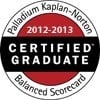You're watching your sales team, and you can feel it. Some reps are crushing their quota month after month, but others are consistently falling short. This inconsistency makes your sales performance management feel more like guesswork, and that's a frustrating place for any sales leader to be.
I've spent over two decades in enterprise software sales, and I know that feeling all too well. It is why having a solid system for sales performance management is so critical to team performance. It's the key to turning unpredictability into a reliable revenue engine.
You probably hear that term thrown around a lot. It is not just about running reports or having weekly check-ins. It is a strategic management process that aligns your sales reps, your goals, and your actions to create predictable, scalable revenue growth.
What Exactly Is Sales Performance Management?
At its heart, sales performance management (SPM) is a complete system for analyzing and improving the performance of your sales team. Think of it as the engine that drives your entire sales operation forward. It is not just about managing people; it is about optimizing every part of the sales process to achieve better results.
SPM breaks down into a few core activities, forming a continuous cycle of improvement. This includes setting strategic sales goals, coaching your salespeople, and creating smart compensation plans. It also involves using data from performance management software to make better decisions for your sales organization.
This approach connects the dots between what your team does every day and the company's biggest goals. While a manager handles forecasting and daily tasks, an SPM strategy looks at the bigger picture. It is about building a framework for effective sales that makes success repeatable, not accidental, through a well-defined sales performance management process.
Why You Can't Ignore Sales Performance Management
Ignoring a formal SPM strategy is like trying to navigate a ship without a rudder. You might move, but you will not control the direction. When you get this right, the benefits are felt across the entire organization.
A strong performance management process leads directly to increased revenue because it helps you identify what is working and replicate it across the team. It also builds a more engaged and motivated sales force. A Gallup study shows that highly engaged teams see a 21% greater profitability, and good SPM is a direct path to that engagement.
Effective SPM also helps reduce your churn rate among sales staff. When sales reps feel supported and have a clear path to success, they are less likely to leave. This saves you a massive amount in hiring and training costs, creating a stable, experienced team that consistently improves sales.
A Practical Guide to Your Sales Performance Management Process
.png?width=3096&height=2808&name=How%20To%20Boost%20Your%20Sales%20with%20Effective%20Performance%20Management%20-%20visual%20selection(1).png)
Putting a system in place does not have to be overwhelming. I have helped dozens of companies, from startups to large enterprises using Oracle Sales or SAP, build their processes from the ground up. You can start with these fundamental steps to build your own sales performance management plan.
Step 1: Set Clear and Attainable Goals
Your team can't hit a target they can't see. Your sales goals need to be incredibly clear, but they also need to feel achievable. This is where I often recommend using the SMART goal framework: Specific, Measurable, Achievable, Relevant, and Time-bound.
I always coach leaders to set two types of goals to properly set targets. You need outcome goals, like hitting a certain revenue number or closing a specific number of deals. You also need activity goals, such as making a set number of calls or sending a specific number of prospecting emails.
Within your sales performance management system, you can set up dashboards to track both kinds of goals automatically. This gives both you and the salesperson immediate visibility into their progress. This transparency eliminates confusion and keeps everyone focused on their sales quotas and broader sales targets.
Step 2: Develop a Solid Sales Process
Your top performers probably follow a process, even if they do not realize it. The goal is to document that process and make it the standard for everyone. A documented sales process is your playbook for success, a cornerstone of effective sales performance management strategies.
This process should outline every stage of the sales funnel, from lead generation to the final close. What actions need to be taken at each stage? What are the exit criteria to move a deal to the next stage? A well-defined sales plan removes guesswork.
This step is also where sales planning meets execution. By defining the process, you can identify potential knowledge gaps in your team. For example, if reps are struggling to move deals from the proposal stage to closing, it might indicate a need for better negotiation training.
Step 3: Implement Regular and Effective Coaching
This might be the most important step of all. Coaching is not about looking at a spreadsheet and asking why someone did not hit their number. It is about working alongside your reps to develop their skills and fix what is holding them back from reaching their full potential.
Good coaching involves reviewing calls, analyzing deal strategy, and even doing role-plays to practice difficult conversations. Sales leaders should aim to create custom sales coaching plans, because every company and every salesperson has different needs. The goal of this performance management strategy is incremental, consistent improvement that will optimize sales.
A report from the CSO Insights Sales Talent Study found that companies with formal coaching programs see significantly higher win rates. This is because coaching directly impacts the skills that close deals. Regular coaching is a pillar of strong team performance management.
Step 4: Use Data to Drive Decisions
Your gut instinct is valuable, but it is no substitute for hard data. An effective sales performance management strategy is built on metrics. You need to know your numbers inside and out to improve sales efficiency.
Start by identifying the Key Performance Indicators (KPIs) that matter most for your business. Do not get lost in vanity metrics. Focus on what really moves the needle for your sales teams.
Here are some of the most critical KPIs to track within your performance management software:
| Metric | What It Tells You |
|---|---|
| Win Rate | The effectiveness of your sales process from opportunity to close. |
| Average Deal Size | The average revenue you get from a single closed deal. |
| Sales Cycle Length | How long it takes, on average, to close a deal. |
| Lead Response Time | How quickly your team is following up with new leads. |
| Quota Attainment | The percentage of the sales team that is meeting or exceeding their sales quotas. |
| Pipeline Velocity | How quickly deals are moving through your pipeline, indicating sales efficiency. |
I often help clients discover prospects they never knew they had through their CRM data. Your system can identify companies that visit your website even if no one fills out a form. We analyze this data to build a proactive prospecting methodology that turns those anonymous visitors into qualified leads.
Modern SPM software even incorporates machine learning to predict which deals are most likely to close. This allows sales leaders to allocate resources more effectively. This data-driven approach is fundamental to sales planning and performance management.
Step 5: Structure Your Incentive and Compensation Plans
Money is a powerful motivator, so your compensation plan has to align directly with your company's goals. If you want reps to focus on landing larger deals, then your commission structure should reward that. If the goal is new customer acquisition, the compensation plans should reflect that, too.
But incentive compensation is not just about commissions. A well-rounded sales incentive management program can include bonuses, SPIFs (Sales Performance Incentive Funds), and even non-monetary rewards. Recognizing a rep's hard work in front of the whole company can sometimes be more powerful than a small bonus check.
The key is to keep the compensation plan simple. If your team can't easily understand how they get paid, the sales incentive is not working. The best compensation management follows a clear formula: if a rep does X, they receive Y, which reinforces the desired behaviors.
Creating a Complete Sales Performance Management Framework
.png?width=1914&height=1530&name=How%20To%20Boost%20Your%20Sales%20with%20Effective%20Performance%20Management%20-%20visual%20selection(2).png)
The steps above are the building blocks of a comprehensive sales performance management framework. To truly succeed, you need to connect these pieces into a cohesive system. This involves a clear management strategy that guides how each element supports the others.
Your framework should begin with a clear definition of your sales strategy. What markets are you targeting? What is your ideal customer profile? This strategy informs everything from how you design sales territories to the KPIs you track.
From there, you must develop strategies for each component. For instance, your coaching strategy should address how you identify skill gaps using performance data. Your territory management strategy should be based on account potential and workload balance to ensure fair quota management.
Finally, this entire framework should be supported by a robust sales performance management platform. While a CRM is essential, a dedicated sales performance management system integrates data from various sources to provide a single source of truth for your entire sales organization. This helps automate processes and provides insights that are difficult to uncover manually.
Tools That Can Help Your SPM Strategy
Having the right process is essential, but technology can make that process much more efficient. A good tech stack acts as a force multiplier for your sales team. It automates mundane tasks and gives you the data you need to make smart decisions.
Your Customer Relationship Management (CRM) system is the foundation of your performance management system for sales team. It is the central hub for all customer interactions, deal information, and performance data. Getting the most out of a powerful CRM is crucial for SPM sales performance management.
Configure-Price-Quote (CPQ) tools are another game-changer, especially in complex sales. A CPQ tool automates the creation of quotes, making sure they are accurate and professional every single time. There are many great CPQ tools, including options within the Salesforce, Oracle Sales, and SAP ecosystems.
Specialized sales performance management tools go a step further. This management software often includes dedicated modules for incentive compensation management, quota management, and territory management. Leading sales performance management companies offer solutions that provide deep analytics and forecasting powered by machine learning.
Finally, do not forget about the top of your funnel. A targeted lead generation campaign can fuel the entire sales engine. These platforms feed high-quality leads directly into your sales performance management process, giving your sales reps more opportunities to succeed.
Conclusion
Building a successful sales performance management framework is a marathon, not a sprint. It is a continuous cycle of setting goals, executing the process, coaching your people, and analyzing the results to get better. This system transforms individual sales from an art into a science, creating predictable outcomes.
A well-run sales performance management program aligns your team around a common mission. It gives them the clarity, skills, and motivation they need to succeed through a clear sales performance management strategy. When your people win, the business wins, too.
We are a full-service Hubspot Certified Inbound Marketing and Sales Agency. In addition, we work to integrate your SAP System with Hubspot and Salesforce, where we have a deep delivery capability based on years of experience. Please our book a meeting service to get started.



